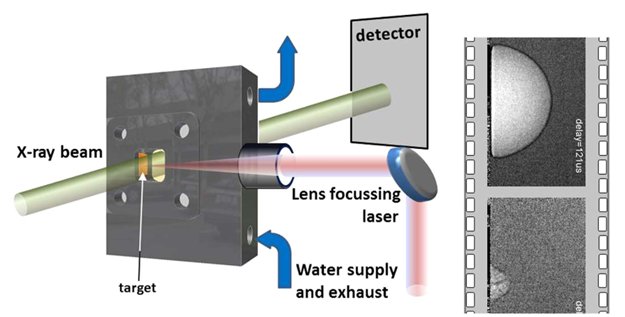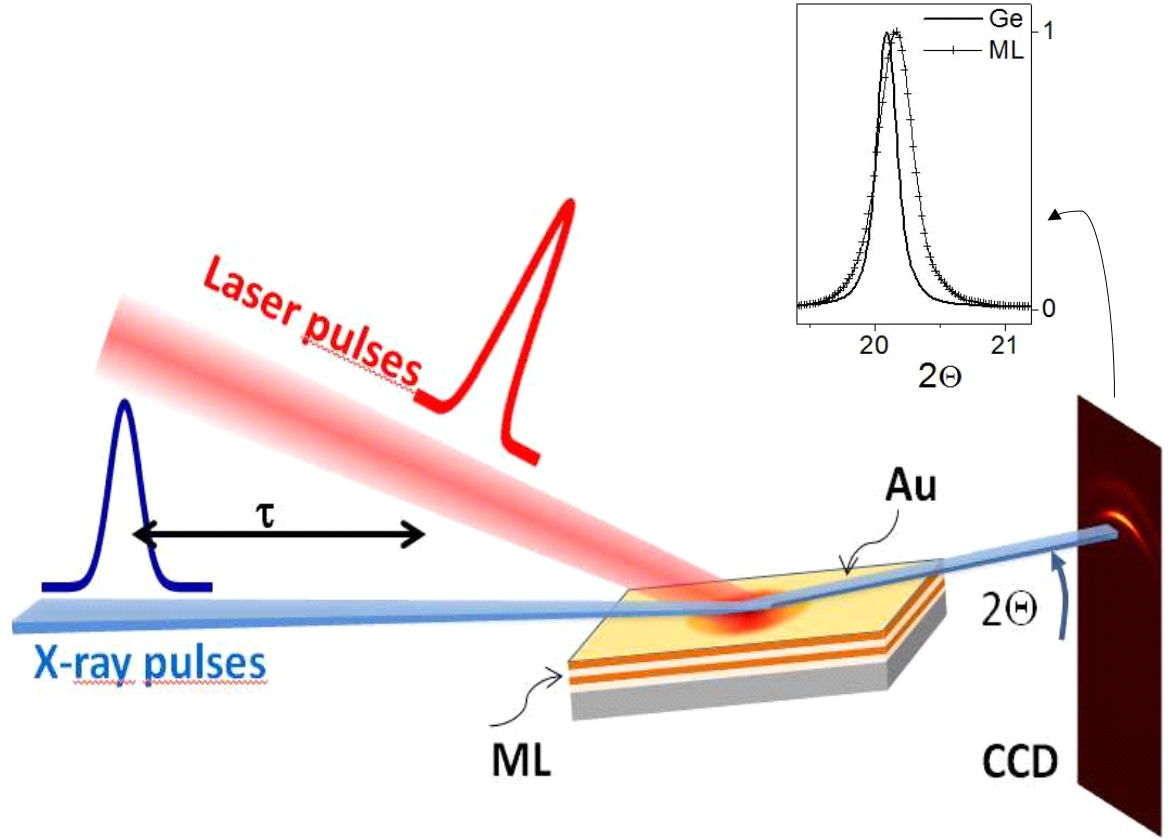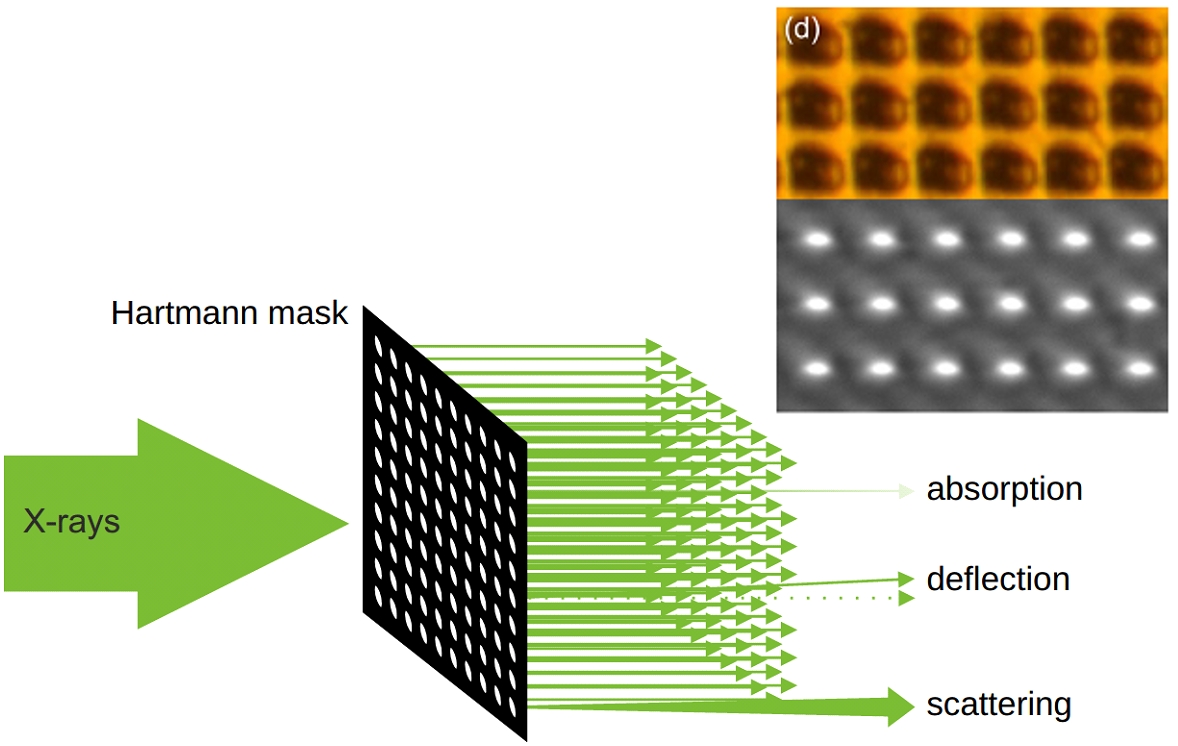Ultrafast Laser-based Nanomaterials Research
Nanoscience explores the spatial region between bulk material and its atomic or molecular constituents. The change of physical properties in this region can be abrupt and display a number of novel properties. Experimental methods which can both resolve the structure and the temporal dynamics of the nanostructures are inherent to the understanding of this class of systems. We use synchrotron radiation x-ray scattering and spectroscopy methods combined with laser-based ultrafast methods for the dynamic characterization of nanoscale matter, molecules and crystalline materials, in particular for the analysis of nanoscale dynamics, phonon excitation or phase transitions in the condensed phase. Special emphasis is on the exploitation of the „low alpha mode“ at the KIT Synchrotron, which provides pulses as short as 1 picosecond. In the x-ray regime this can be used for pump-probe experiments with femtosecond laser excitation, while in the THz region the coherent emission of the radiation can be sampled by means of electro-optical techniques.
Central questions are:
- Can light pulses manipulate the phase of functional materials; can one use such effects to switch ferroelectrics, for instance? What are the mechanisms down to an atomic level ?
- Can one watch molecules during the course of a chemical reaction ?
- How do metallic nanoparticles, or nanoparticles with bound proteins, react upon irradiation with intense light pulses ? Can one use these reactions to achieve material processing on a nanoscale, can one achieve targeted effects in biologic materials ?
The main topics of research of the group are:
- Laser control of materials via lattice excitation
- Structural dynamics of nanoparticles
- Nanoparticle synthesis
- Novel sources and methods with ultrahigh time resolution
 |
Pulsed laser ablation (LAL) and fragmentation (LFL)
Pulsed laser ablation (LAL) and fragmentation (LFL) in liquids has received a lot of attention in the past years due to its prospects as a generalized tool for green production of pure nanoparticles in a wide class of materials. Within the cooperation, we study the formation of nanoparticles by a set of structural methods with high time resolution in situ.
Left: typical setup for probing the structure evolution during pulsed laser ablation of a metal target (yellow block in left image) under water. Due to the extreme conditions a cavitation bubble develops, which contains at first most of the ablated material.
See highlight article: https://www.ips.kit.edu/2786_6278.php |
|
Thermal and non-thermal transport in nanostructures and thin films
Thermal and non-thermal transport in nanostructures and thin films are important information for understanding functional materials, such as thermoelectrics. Within a collaboration with University Münster (Material Science) we investigate heat conduction in thin films that are tailored for thermal transport by introducing interfaces. Isotope modulation is one such approach that does not alter electronic properties, but only phonon band structure. Thermal behaviour can be accessed on and nanoscale level by using time-resolved scattering methods.
Right: Pump-probe experiment of a time-resolved thermometry probe of a thin gold transducer film on a nanostructured layer structure. The film acts a heat transducer after absorbing pulsed laser light and signals the time-dependent cooling through probing its lattice expansion by picosecond x-ray pulses. modulation is one such approach that does not alter electronic properties, but only phonon band structure. Thermal behaviour can be accessed on and nanoscale level by using time-resolved scattering methods.
See highlight article: https://www.ips.kit.edu/2786_2863.php
|
|
|
|
X-ray dark-field imaging
X-ray dark-field imaging by Shack-Hartmann contrast variation has been developed in order to visualize the dynamics distribution of nanoparticles in pulsed-laser ablation in liquids in a single-shot-type approach. A wide x-ray beam is partitioned into an array of small individual beamlets, such that each probes absorption, differential phase and dark-field contrast by change of intensity, position and width of the beamlets, respectively. While the detector resolution is sacrificed to probe the beamlets, this approach does not require physical moving of parts or scanning. Therefore it applies well to single-shot probing.
The Shack-Hartmann masks are produced in cooperation with the Institute of Microstructure Technology at KIT either by lithography methods (SHARX) or through Ni-formed stamp masters (CARL).
See highlight article: https://www.ips.kit.edu/2786_6162.php |
The group provides expertise on ultrafast optical methods and pulsed lasers, serving research on laser-matter interactions, but also diagnostics of the electron pulses in the ring and the development of new accelerator concepts and techniques. Research is funded by KIT and by individual grants of the German Science foundation (DFG). Collaborations are related to the Center for Applied Photonics Konstanz. We acknowledge the support and provision of beam time by IPS, SLS and ESRF.
Selected Publications
-
Caging Effect of Unbound Graphene Oxide Nanosheets during Gold Colloid Fragmentation under Electrostatic Repulsion
Pokhrel, Y.; Tack, M.; Levantino, M.; Reichenberger, S.; Plech, A.
2025. The Journal of Physical Chemistry C, 129 (17), 8252–8261. doi:10.1021/acs.jpcc.5c00439 -
Time-resolved probing of laser-induced nanostructuring processes in liquids
Spellauge, M.; Redka, D.; Mo, M.; Song, C.; Huber, H. P.; Plech, A.
2025. Beilstein Journal of Nanotechnology, 16, 968–1002. doi:10.3762/bjnano.16.74 -
Adsorption of Colloidal Nanoparticles to Supports: Employing Electrostatic Charge Screening and Barrierless Self‐Assembly as Nanointegration Strategy
Tack, M.; Plech, A.; Reichenberger, S.
2024. ChemPhysChem, 25 (23). doi:10.1002/cphc.202400121 -
Laser-initiated electron and heat transport in gold-skutterudite CoSb3 bilayers resolved by pulsed x-ray scattering
Plech, A.; Gaal, P.; Schmidt, D.; Levantino, M.; Daniel, M.; Stankov, S.; Buth, G.; Albrecht, M.
2024. New Journal of Physics, 26 (10), Art.-Nr.: 103024. doi:10.1088/1367-2630/ad8674 -
Physical Regimes and Mechanisms of Picosecond Laser Fragmentation of Gold Nanoparticles in Water from X-ray Probing and Atomistic Simulations
Plech, A.; Tack, M.; Huang, H.; Arefev, M.; Ziefuss, A. R.; Levantino, M.; Karadas, H.; Chen, C.; Zhigilei, L. V.; Reichenberger, S.
2024. ACS Nano, 18 (15), 10527–10541. doi:10.1021/acsnano.3c12314 -
In Situ Study of the Interface-Mediated Solid-State Reactions during Growth and Postgrowth Annealing of Pd/a-Ge Bilayers
Krause, B.; Abadias, G.; Babonneau, D.; Michel, A.; Resta, A.; Coati, A.; Garreau, Y.; Vlad, A.; Plech, A.; Wochner, P.; Baumbach, T.
2023. ACS Applied Materials & Interfaces, 15 (8), 11268–11280. doi:10.1021/acsami.2c20600 -
Bulk morphology of porous materials at submicrometer scale studied by dark-field x-ray imaging with Hartmann masks
Zakharova, M.; Mikhaylov, A.; Reich, S.; Plech, A.; Kunka, D.
2022. Physical Review B, 106 (14), Art.-Nr.: 144204. doi:10.1103/PhysRevB.106.144204 -
Speciation in nanosecond laser ablation of zinc in water
Reich, S.; Klügl, Y.; Ziefuss, A.; Streubel, R.; Göttlicher, J.; Plech, A.
2022. Science China Physics, Mechanics & Astronomy, 65 (7), Art.Nr. 274205. doi:10.1007/s11433-021-1857-1 -
Beamline setup for in situ measurements of particles in turbulent spray flames using small angle X-ray scattering
Simmler, M.; Meier, M.; Rank, L.; Buth, G.; Plech, A.; Nirschl, H.
2022. Proceedings of the Combustion Institute, 39 (1), 949–957. doi:10.1016/j.proci.2022.08.002 -
Low Efficiency of Laser Heating of Gold Particles at the Plasmon Resonance: An X-ray Calorimetry Study
Plech, A.; Ziefuß, A. R.; Levantino, M.; Streubel, R.; Reich, S.; Reichenberger, S.
2022. ACS Photonics, 9 (9), 2981–2990. doi:10.1021/acsphotonics.2c00588 -
Photoluminescence of Fully Inorganic Colloidal Gold Nanocluster and Their Manipulation Using Surface Charge Effects
Ziefuss, A. R.; Steenbock, T.; Benner, D.; Plech, A.; Göttlicher, J.; Teubner, M.; Grimm-Lebsanft, B.; Rehbock, C.; Comby-Zerbino, C.; Antoine, R.; Amans, D.; Chakraborty, I.; Bester, G.; Nachev, M.; Sures, B.; Rübhausen, M.; Parak, W. J.; Barcikowski, S.
2021. Advanced materials, 33 (31), Art.Nr. 2101549. doi:10.1002/adma.202101549 -
Structural dynamics probed by X-ray pulses from synchrotrons and XFELs
Levantino, M.; Kong, Q.; Cammarata, M.; Khakhulin, D.; Schotte, F.; Anfinrud, P.; Kabanova, V.; Ihee, H.; Plech, A.; Bratos, S.; Wulff, M.
2021. Comptes rendus physique, 22 (S2), 75–94. doi:10.5802/crphys.85 -
Layer-by-Layer Spray-Coating of Cellulose Nanofibrils and Silver Nanoparticles for Hydrophilic Interfaces
Chen, Q.; Brett, C. J.; Chumakov, A.; Gensch, M.; Schwartzkopf, M.; Körstgens, V.; Söderberg, L. D.; Plech, A.; Zhang, P.; Müller-Buschbaum, P.; Roth, S. V.
2021. ACS applied nano materials, 4 (1), 503–513. doi:10.1021/acsanm.0c02819 -
Shack–Hartmann wavefront sensors based on 2D refractive lens arrays and super-resolution multi-contrast X-ray imaging
Mikhaylov, A.; Reich, S.; Zakharova, M.; Vlnieska, V.; Laptev, R.; Plech, A.; Kunka, D.
2020. Journal of synchrotron radiation, 27 (3), 788–795. doi:10.1107/S1600577520002830 -
In situ speciation and spatial mapping of Zn products during pulsed laser ablation in liquids (PLAL) by combined synchrotron methods
Reich, S.; Goettlicher, J.; Ziefuß, A.; Streubel, R.; Letzel, A.; Menzel, A.; Mathon, O.; Pascarelli, S.; Baumbach, T.; Zuber, M.; Gökce, B.; Barcikowski, S.; Plech, A.
2020. Nanoscale, 12 (26), 14011–14020. doi:10.1039/D0NR01500H -
In situ structural kinetics of picosecond laser-induced heating and fragmentation of colloidal gold spheres
Ziefuß, A.; Reich, S.; Reichenberger, S.; Levantino, M.; Plech, A.
2020. Physical chemistry, chemical physics, 22, 4993–5001. doi:10.1039/C9CP05202J -
Materials synthesis in a bubble
Barcikowski, S.; Plech, A.; Suslick, K. S.; Vogel, A.
2019. MRS bulletin, 44 (05), 382–391. doi:10.1557/mrs.2019.107 -
Inverted Hartmann mask for single-shot phase-contrast x-ray imaging of dynamic processes
Zakharova, M.; Reich, S.; Mikhaylov, A.; Vlnieska, V.; Santos Rolo, T. D.; Plech, A.; Kunka, D.
2019. Optics letters, 44 (9), 2306–2309. doi:10.1364/OL.44.002306 -
Early appearance of crystalline nanoparticles in pulsed laser ablation in liquids dynamics
Reich, S.; Letzel, A.; Menzel, A.; Kretzschmar, N.; Gökce, B.; Barcikowski, S.; Plech, A.
2019. Nanoscale. doi:10.1039/C9NR01203F -
Incubation effect of pre-irradiation on bubble formation and ablation in laser ablation in liquids
Reich, S.; Letzel, A.; Gökce, B.; Menzel, A.; Barcikowski, S.; Plech, A.
2019. ChemPhysChem, 20 (8), 1036–1043. doi:10.1002/cphc.201900075 -
Structural and Thermal Characterisation of Nanofilms by Time-Resolved X-ray Scattering
Plech, A.; Krause, B.; Baumbach, T.; Zakharova, M.; Eon, S.; Girmen, C.; Buth, G.; Bracht, H.
2019. Nanomaterials, 9 (4), Article: 501. doi:10.3390/nano9040501 -
Time and mechanism of nanoparticle functionalization by macromolecular ligands during pulsed laser ablation in liquids
Letzel, A.; Reich, S.; Santos Rolo, T. dos; Kanitz, A.; Hoppius, J.; Rack, A.; Olbinado, M.; Ostendorf, A.; Gökce, B.; Plech, A.; Barcikowski, S.
2019. Langmuir, 35 (8), 3038–3047. doi:10.1021/acs.langmuir.8b01585 -
How the re-irradiation of a single ablation spot affects cavitation bubble dynamics and nanoparticles properties in laser ablation in liquids
Letzel, A.; Santoro, M.; Frohleiks, J.; Ziefuß, A. R.; Reich, S.; Plech, A.; Fazio, E.; Neri, F.; Barcikowski, S.; Gökce, B.
2018. Applied surface science, 473, 828–837. doi:10.1016/j.apsusc.2018.12.025 -
Primary particle diameter differentiation and bimodality identification by five analytical methods using gold nanoparticle size distributions synthesized by pulsed laser ablation in liquids
Letzel, A.; Gökce, B.; Menzel, A.; Plech, A.; Barcikowski, S.
2018. Applied surface science, 435, 743–751. doi:10.1016/j.apsusc.2017.11.130 -
A Shack-Hartmann Sensor for Single-Shot Multi-Contrast Imaging with Hard X-rays
Santos Rolo, T. dos; Reich, S.; Karpov, D.; Gasilov, S.; Kunka, D.; Fohtung, E.; Baumbach, T.; Plech, A.
2018. Applied Sciences, 8 (5), Art.Nr. 737. doi:10.3390/app8050737 -
Scalable, large area compound array refractive lens for hard X-rays
Reich, S.; Santos Rolo, T. dos; Letzel, A.; Baumbach, T.; Plech, A.
2018. Applied physics letters, 112 (15), 151903. doi:10.1063/1.5022748 -
X‑ray spectroscopic and stroboscopic analysis of pulsed‑laser ablation of Zn and its oxidation
Reich, S.; Göttlicher, J.; Letzel, A.; Gökce, B.; Barcikowski, S.; Santos Rolo, T. dos; Baumbach, T.; Plech, A.
2018. Applied physics / A, 124 (1), 71. doi:10.1007/s00339-017-1503-3


